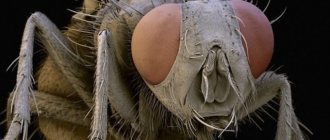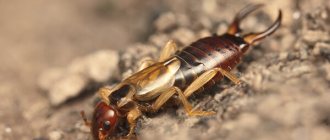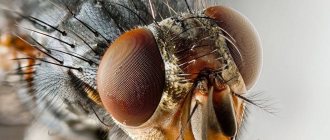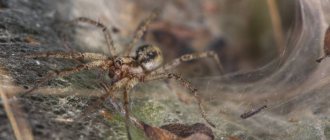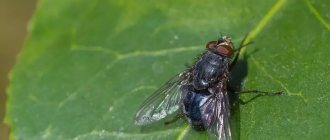Types of Drosophila midges
Honey flies are a harmless insect, although annoying. Scientists count several thousand species, although only 1,500 of them are described in detail, 40 live in European countries.
Drosophila melanogaster (other names: fruit fly, honey fly, fruit fly, small fly, wood sorrel) is a small, approximately 3 mm in length, insect belonging to the family Drosophiliadae, order Diptera. External characteristics: red eyes and brown-yellow coloration with black rings on the abdomen. The female's body is approximately 2.5 mm, while the male is smaller and has a darker rear. It is these midges that usually appear in houses and apartments.
By the way, the melanogaster subspecies is highly valued by geneticists because it is ideal for experiments.
And especially for aquarists, a wingless subtype has been bred, which is used to feed fish and reptiles.
Drosophila funebris (called the large or vinegar fly) is larger than melanogaster by an average of 1 mm. It lives mainly near ponds, barrels or other vessels with fermenting/rotting liquids, and less often found in fruits.
How do Drosophila midges reproduce?
Where do fruit flies lay their eggs? The female insect lays eggs, the size of which is about 0.5 mm, in rotting fruit or any other organic material. After approximately 10 days, white larvae hatch, measuring up to 3.5 mm in size.
At first they are on the surface of the breeding site, then they go deeper, where pupation occurs. After 4 days, adults appear - imagoes, which reach sexual maturity within 8-12 hours.
Cultivation of soil in pots
If midges have infested flower pots, and you are not sure that the indoor plant will survive replanting, you need to use the previous traps and ways to repel midges, and also start cultivating the soil. There are several solutions that will help with this:
- garlic - rub the garlic head and pour boiling water (0.5 liters) and leave for 2-4 hours. The soil is watered with this solution and the plant is also sprayed. The remaining pulp can be buried to the roots;
- soapy - you need to grate a quarter of the laundry soap, dissolve it in a liter of water, spray the plant once a week;
- sulfur - four matches are stuck into the ground with the head down, replaced every other day. The plant must be watered after each replacement of matches;
- antiparasitic - any antiparasitic product purchased at a veterinary store will do. Dilute according to the instructions in a dosage suitable for puppies and water the plant.
If the plant is able to survive transplantation, then it is better to acquire new land.
Life cycle of the midge
An insect goes through three stages of development. During growth, the larvae molt twice: 24 and 48 hours after formation. At this time, they feed on the substances of the decomposing fruit and microorganisms involved in this process. After 4-5 days they pupate. They spend another 4-5 days in this state, during which metamorphoses occur that change, develop and prepare the organs for transformation into an imago.
I recommend reading: How to remove a tick from your body
The first mating in females occurs no earlier than 12 hours after final development. Only from the second day they lay eggs, 50-80 eggs at a time.
Depending on the air temperature, the answer to the question of how long fruit flies live differs. In the warm period - 10 - 20 days, in the cold - up to 2.5 months.
Why are midges dangerous?
Despite their size, midges can cause significant harm to people and animals.
- If you accidentally eat a fruit or vegetable infected with eggs and larvae of midges, this can lead to poisoning and intestinal infection.
- Bites from flesh-eating midges can be painful, cause an allergic reaction, and take a long time to heal.
- Bacteria and viruses can be transmitted through midge bites.
Regardless of whether you have herbivorous or carnivorous midges, they can and should be destroyed. You can do this yourself or with the help of SES. The Dez Group service, certified by Rospotrebnadzor, with more than 13 years of experience, will help you get rid of insects quickly, safely and with a guarantee of results on objects and territories of any scale and purpose.
Where do Drosophila midges come from?
The microscopic wings of fruit flies are not designed to cover long distances. Scientists have calculated that on average a midge moves 180 m per day. So where do Drosophila midges come from at home, especially in winter, when doors, windows and all sorts of cracks are closed and insulated? Let's figure it out.
In nature, these insects feed on the sap and rotting remains of plants. Accordingly, they live in gardens, dachas, or simply on fruit trees.
There are several ways to get into the apartment:
- with fruits and vegetables (rarely midges, usually their eggs);
- with the soil that remained on the fruits, or was brought for plant replanting;
- through windows if there are garbage containers or fruit trees nearby;
- through ventilation from neighbors or from the basement;
- breed in food that is stuck in the drain pipe.
Even the most careful connoisseurs of cleanliness are not immune from such a misfortune, who do not leave food on the tables, wash their dishes and pets’ bowls until they shine, regularly take out the trash and sort through the contents of the refrigerator, throwing out rotten fruits.
Yes, it’s unpleasant to see fruit flies covering a fruit bowl or your favorite houseplant in a cloud. But don't be discouraged! Of course, the contents of the fruit bowl will have to be thrown out, but the flower leaves can be saved.
Why are midges dangerous?
Despite their size, midges can cause significant harm to people and animals.
- If you accidentally eat a fruit or vegetable infected with eggs and larvae of midges, this can lead to poisoning and intestinal infection.
- Bites from flesh-eating midges can be painful, cause an allergic reaction, and take a long time to heal.
- Bacteria and viruses can be transmitted through midge bites.
Regardless of whether you have herbivorous or carnivorous midges, they can and should be destroyed. You can do this yourself or with the help of SES. The Dez Group service, certified by Rospotrebnadzor, with more than 13 years of experience, will help you get rid of insects quickly, safely and with a guarantee of results on objects and territories of any scale and purpose.
How to get rid of fruit flies in an apartment
Once inside an apartment, flies multiply quickly and are very difficult to remove. If you leave a rotting fruit or vegetable on the table overnight, by the morning you will have a full kitchen of winged “guests.”
To get rid of fruit flies, first find the source of their food and reproduction, put it not just in the trash, but away from the house.
You should always follow preventive measures:
- Wash your pets' dishes regularly;
- make sure that pieces of food do not fall into the cracks, and that there are no wet or spoiled fruits lying anywhere;
- Store harvests and fruits purchased for future use, if possible, in the basement;
- Take out the trash in a timely manner, wash the bin, and do not leave it open;
- Water indoor plants less often; it is better to place them in those rooms where the fruit fly has nothing to eat.
If you constantly monitor this, then even if flies appear, after a while they will disappear on their own, without the use of chemicals. The timing depends on how long they can live without food.
In addition, immediately rinse vegetables and fruits brought home with hot water, or better yet, pour boiling water over them; this will kill the eggs. In late autumn - early spring, when it is cold outside and fruit flies move closer to warm places, it is enough to simply ventilate the rooms daily.
How and where do midges develop and where do they come from?
Flies develop in places where there has been no cleaning for a long time. But the question still arises: how do they reproduce? After all, their development comes from conception. Even if you clean on time and do general cleaning (at least every day), as soon as some fruit spoils, this midge is right there. How does this happen?
This can be explained very simply: an adult lays its eggs on ripe and unspoiled fruit, even one that grows in the garden. Bringing any fruit, vegetable or berries from a store, market, street or garden, a person, along with them, delivers these hated insects to his home. And in order for them to develop, they need a rotting environment. And if the brought product begins to deteriorate , then the development of this midge will go from egg to adult. These insects not only develop quickly, but also develop in large numbers. This is where large concentrations of these parasites appear.
Precautionary measures
If you take some steps, midges may not appear in the kitchen.
- All fruits, before putting them in a vase , must be thoroughly washed and dried, since wet fruits are more susceptible to spoilage and rot.
- It is best to wash the fruit with hot water or pour boiling water over it, which will destroy all larvae, if any.
- Rotten, damaged or too soft plums, apricots, apples, pears and other fruits must be removed from the fruit bowl in a timely manner
- Berries and fruits that spoil quickly : raspberries, strawberries, cherries and other berries should not be placed on the table for a long time - they should be eaten quickly. The same should be done with chopped and peeled fruits - pineapple, watermelon, melon, banana.
- The best way is to put the fruit in the refrigerator overnight . Preventing the appearance of midges is always easier than fighting it later.
To finally get rid of midges, you need to know the exact cause of their occurrence. Sometimes it happens that no methods help. In such cases, only special chemicals can help, which need to be used to treat the entire room. And after that, never leave fruits, vegetables, berries and other foods on the table overnight.
How to get rid of midges?
When you bring the purchased fruit home, you need to rinse it thoroughly or pour boiling water over it (then the midge eggs will die) and put it in the refrigerator. These insects do not reproduce in the cold . If some fruit has rotted somewhere, you need to immediately get rid of it and immediately wash the place where it was located.
Be sure to frequently check the places where food is stored:
- potato;
- carrot;
- onions, etc.
It is important to clean them from possible rotting. When watering indoor plants, you should not get carried away by saturating the soil too much with water.
You should not store garbage bags and buckets for a long time, as garbage tends to deteriorate , and from here the appearance of midges only increases.
If you follow these rules, then you don’t have to use chemicals - the midges themselves will disappear without even appearing.
